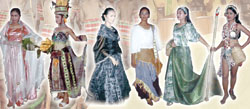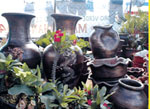Masskara Festival in Bacolod City, Negros Occidental
When Masskara Festival Started?
The festival instills among the people the culture of escapism and obscurantism, where they have to accept and forget their sufferings caused by the exploitation and oppression of the landlords. In this city, people are encouraged by the organizers, mostly big business and hacenderos (big landlords), to forget the economic hardships and depression which happen especially during tiempo muerto (dead season, or off sugar harvest-milling season). Bacolod is the capital city of Negros Occidental, known as the Sugar Bowl of the Philippines and is part of Western Visayas in central Philippines.
Originally and ironically, the masks reflected the people’s grief over the loss of their numerous loved ones when, in 1979, Negros Navigation’s luxury liner MS Don Juan crashed with a tanker. Five years before, there was a big drop in sugar production. The people of Negros suffered from the excess of sugar in the world market caused by the Caribbean sugar crisis and the introduction of sugar substitute like the High Fructose Corn Syrup in the United States. All these led to the holding of the first Masskara Festival in 1980. Santiago’s original proposal to hold annual parade using masks to capture the crisis in Negros, was changed by the local elite into street dancing and merry-making festival. This rich imagery of masks was used by the hacenderos and local politicians to hide the suffering of the Negrenses. From then on, Masskara Festival became one of the popular attractions in Negros, drawing thousands of people within and outside the country.
Originally and ironically, the masks reflected the people’s grief over the loss of their numerous loved ones when, in 1979, Negros Navigation’s luxury liner MS Don Juan crashed with a tanker. Five years before, there was a big drop in sugar production. The people of Negros suffered from the excess of sugar in the world market caused by the Caribbean sugar crisis and the introduction of sugar substitute like the High Fructose Corn Syrup in the United States. All these led to the holding of the first Masskara Festival in 1980. Santiago’s original proposal to hold annual parade using masks to capture the crisis in Negros, was changed by the local elite into street dancing and merry-making festival. This rich imagery of masks was used by the hacenderos and local politicians to hide the suffering of the Negrenses. From then on, Masskara Festival became one of the popular attractions in Negros, drawing thousands of people within and outside the country.
During this festival every October, the city’s public plaza is brought alive into a huge beer garden. There is also Masskara Street-dancing contests highlighting the whole festival. Masskara Festival was intended as an encouragement to all to fight back and to keep smiling despite the sugar problems, and highlighted that hope still existed. Since then, the smiling masks have become the city's symbol, thus earning its tag as the "City of Smile." This annual festival, which has become one of Philippines best known tourist attraction, has been earning raves both from local and foreign tourists. Masskara Festival has also been judged the most beautiful and colorful festival among the various contingents from other countries.
The Masskara Festival through the years gives the people of Negros, as well as local and foreign visitors, a chance to drink and be merry for 20 days. Originally designed to show the hardships of the people of Negros, the Masskara Festival has become a tool of escapism and a way to generate revenues for big business. It has indeed come a long way, and it is clear that the path turn away from the progressive goal.
Bacolod City is known for the popular Masskara Festival which takes place here Oct. 1-20. Local and foreign visitors get a chance to enjoy 20 days of merry making, beer drinking, dining and street dancing. On the weekend nearest to 19 October, the biggest party in Bacalod is scheduled to take place. Bacalod is the capital city of the country's sugar-producing province of Bocalenos.
Bacolod City is known for the popular Masskara Festival which takes place here Oct. 1-20. Local and foreign visitors get a chance to enjoy 20 days of merry making, beer drinking, dining and street dancing. On the weekend nearest to 19 October, the biggest party in Bacalod is scheduled to take place. Bacalod is the capital city of the country's sugar-producing province of Bocalenos.
The term Masskara is created from two words: mass, meaning crowd, and the Spanish word cara, for face; thus the double meaning for "mask" and "many faces". It was coined by Ely Santiago, a painter, cartoonist, and cultural artist, who devoted show in his art works the many faces of Negrenses overwhelmed with various crises.
A smiling mask, which is the symbol of the fiesta was conceived by the organizers to show the happy spirit of the Negrenses despite experiencing bad times in the sugar industry.
Throughout the week, people from all over the Visayas, gather to the town plaza. They join Bacoleños in the non-stop round of festivities. Even if you don't feel like dancing and singing, the pig catching and pole climbing competitions are musts. Some are also trying their luck and testing their skills in mask-making contests, disco king and queen competitions, coconut-milk drinking to name a few.
Masks are the order of the day at the Masskara parade, as brightly-costumed men and women dance and strut in the streets. Their beaming faces are be-dimpled, smiling and laughing in molded clay or papier-mâché. Every group is represented: civil associations, commercial establishments, schools, even private and government organizations. They march out in excited crowd wearing their painted masks and elaborate costumes, all vying for prizes in judging that will be held in the afternoon. The festival also benefits Bacolod tourism not only because tourists flock the city during this time to join the merrymaking but also to buy the orchids and ornate handicrafts on sale.
Sinulog Festival in Kabankalan City, Negros Occidental
Sinulog in Kabankalan City is a hilarious festivity held in commemoration of the triumph of the townspeople against the Moro pirates through the intercession of the Santo Niño.
During the early days, according to tradition, the Katutubo (Locals), especially those living along the coastal areas, were subjected to attacks and harassment by the Moro pirates. The encounters more often resulted in the bloodbath between the Katutubo (Locals) and the pirates, bringing untold miseries and destruction, particularly to the townsfolk. It was in one of these encounters that the Santo Niño intervened and saved the Katutubo (Locals) from further attacks.
To manifest their gratitude, the early Katutubo celebrated the victory by holding a revelry that is the Sinulog today.
The nearby town of Ilog, the first established town in South Negros, whose influence extended beyond its jurisdiction, had not been spared from those attacks.Kabankalan, being adjacent to it, had, then, become a safe refuge, at one time or another, of the townspeople who fled the onslaught of the pirates. The fleeing people would even reach the far-flung Carol-an Valley, a mountain redoubt in Kabankalan then ruled by its legendary leader Datu Manyabog.
Old tale persistently circulating in that town told of an incident that, in the fiercest battle, that proved to be the last, the town defenders were surprised to see the pirates scarily retreating to the seashore and hastily reaching for their vintas to flee homeward.
Curious to see what it was, the townspeople saw a small child atop the church tower waving his shining sword as though driving the pirates away. As the pirates fled in haste, the townspeople indulged in revelry creating hilarious sounds on things they could hold on.
In one sense, Sinulog is a given effort to uphold and perpetuate the tradition that has eventually been lost by the early Filipinos and venerate a patron saint who has played a significant role in the history of the country. In another sense, it recognizes the value of the migrant workers from across the sea who earlier brought in the tradition and eversince had been an indispensable partner of the sugar industry.
Initially staged in 1976 as a festival, Sinulog has grown to become one of the major festivals not only in Negros Occidental but also in Western Visayas. In 2005, Sinulog has gone global in partnership with ABS-CBN network, thereby placing Kabankalan on the road map of festivals in the Philippines.
Pinta Flores Festival in San Carlos City, Negros Occidental
The Pinta Flores Festival is the prestigious city festival of San Carlos City, Negros Occidental which is being held every 5th of November on the same day of the commemoration of the historic “Al Cinco de Noviembre” which is declared a provincial holiday of Negros Occidental.
The festival must be characterized with a vibrant and festive mood of merrymaking as a thanksgiving for the bountiful blessings of the Almighty to our beloved city and its people.
Pasalamat Festival in La Carlota City, Negros Occidental
Pasalamat Festival was based on the tradition of giving thanks to gods of elements after a bountiful harvest by the ancient of Buglas.The festival was first staged on May 1, 1980, after a series of calamities fall in Negros Occidental, particularly in La Carlota City. The labor problem that triggered the workers of Central Azucarera de La Carlota to go on strike and paralyzed the sugar company, Don Juan Tragedy, and some other uncertain conditions prevailing in the early 80’s.
"Sambita" is the original beat for Pasalamat, the late Mayor Luis "Nonoy" Jalandoni Jr. The festival started just like a simple merry making and street dancing to thank Divine Almighty for the Harvest Season blessings and Milling.















